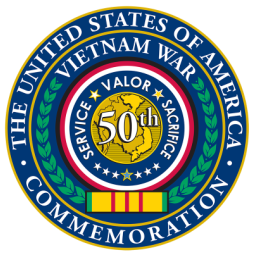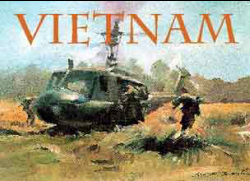
The Vietnam War
" . . . a Ten Thousand Day War"
Fearing the spread of communism, President Kennedy committed the people of the United States of America to defending the fledgling democratic government of South Vietnam. Despite its arguably noble intentions, the war in Vietnam would prove the greatest challenge to American democratic idealism since the Civil War.

During the ten years of America's commitment to the Vietnam war, 55,000 servicemen would be killed or listed as missing; the presidency would change hands three times; and the American people would wage their own war at home against the United States government.
The conflict's roots took shape in July 1954, when France was forced out of Vietnam after one hundred years of colonial rule. In the peace process, the country was partitioned into northern and southern sections, with a U.S.-supported government in the south and a communist republic in the north. On December 20, 1960, the northern Communist Party formed the National Liberation Front (NLF), with the ultimate goal of reunifying the country. In response, U.S. President John F. Kennedy began supplying military equipment and advisors in 1961.
Matters escalated when North Vietnam launched an attack against the C. Turner Joy and the U.S.S. Maddox, two American ships on call in the Gulf of Tonkin, on August 2, 1964. In the U.S. Congress, the Gulf of Tonkin Resolution was passed, allowing for an expanded war effort. Despite hopes for a limited, "controlled" war, the conflict would drag itself out for another decade.
In early 1965, U.S. President Lyndon Johnson ordered the first of many sustained bombing missions over North Vietnam , which would be known as Operation Rolling Thunder. In March of the same year, the first U.S. combat troops were sent to Vietnam.
Despite superior U.S. firepower and technology, the North Vietnamese forces were successful in fighting a protracted, guerilla-style conflict. American fortunes changed for the worse with the Tet Offensive in 1968, in which major South Vietnam cities were attacked. Historians disagree on the literal success of the offensive, but it proved to be a huge boost for North Vietnamese morale, and had the opposite effect on the South Vietnamese and U.S. forces.
As American service members fought in Vietnam, a different kind of war was taking place for American citizens back home, where the struggle was between the American people and their opposition to the fighting in Vietnam; and the American presidency's (beginning with J.F.K.) determination to halt the spread of communism. Incidents such as the police riot in Chicago during the 1968 Democratic National Convention became more common, and even became tragic with the shootings of Kent State University student protestors in 1970.
Ultimately, lacking a credible plan for winning the war, the American government was forced to give in to the wishes of the American people and withdraw its troops from Vietnam. In early January 1973, the Paris Peace Agreement ended open hostilities between the U.S. and North Vietnam. However, the South Vietnamese continued to battle the Communists from March 1973 until the fall of Saigon and the capture of the South Vietnamese presidential palace on April 30, 1975, which brought the war to a close.
So divisive was the conflict in Vietnam and America's involvement that relations among the government, the people and the military would be strained until they were reunified by the Gulf War 25 years later. As evidenced by numerous documentaries, books and films about the war, the hard lessons the U.S. learned in Vietnam are still very much in the public consciousness.
Source: Military.com